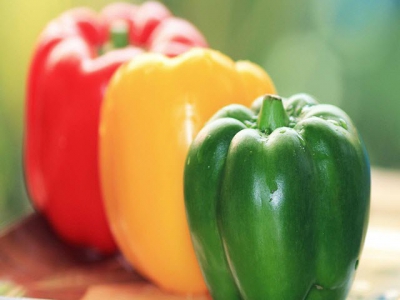What is a pepper, actually?

Peppers belong to the Capsicum genus (family Solanaceae). It’s when we come to common names that things get confusing.
A popular colour combination seen in supermarkets around SA.
Some people will call a chilli a ‘hot pepper’, others will refer to a type of thick-walled, tapered sweet pepper as a ‘paprika’, while yet others will use this name for a long, medium-thin walled, deep-red pepper used for drying to make paprika powder, and so on.
In South Africa, we differentiate between chillies, peppers (usually bell peppers) and paprika. Capsicums have been used in South and Central America since about 7 000BC, with the wild fruit harvested for food and medicinal purposes. Planting began about 2 000 years later, and the development of new varieties began.
It was Columbus who introduced capsicums to Europe. They were an instant hit – and came to be called ‘peppers’ because they were as hot and spicy as black and white pepper of the Piper genus, although not related.
In recent times, capsicums have increased in popularity because of their taste as well as their health-giving benefits.
There are a great number of capsicum species, but only five are of real commercial value. C. annuum is the most popular and includes all the sweet bell peppers and most chillies. The wild varieties of this species are called ‘bird chillies’, because birds find it easy to break off the chilli from the calyx. Birds do not apparently taste the pungency, nor do rodents, as many farmers have found out. Rodents often chew through the most pungent chilli walls to eat the seeds, which are even ‘hotter’.
Cruel gruel
Chickens are no different. I recall as a child having hens that broke open newly laid eggs and ate the contents. To put a stop to this, I mixed mustard and chilli powder with water and poured it into eggshells in the hen house. I reasoned the hens would soon come to associate eggs with extreme discomfort. To my utter amazement, they gobbled up this gruel with relish.
Extremes
Some chillies have been bred to have no pungency and, in fact, may be rather sweet. At the other end of the spectrum are the ‘super hot’ varieties – with names such as ‘Carolina Reaper’, ‘Trinidad Scorpion’ and ‘Naga Viper’ – developed for sauces and for ‘chilli heads’, who think it’s macho to consume chillies which are too hot for most.
(Capsaicin and other related chemicals give chillies their ‘bite’. Capsaicin is also the main ingredient in pepper spray.) Bell peppers have been going through a transformation, with thicker walls being bred and greater emphasis placed on visual appearance, with the fruit required to be smooth and symmetrical.
Most start off as green and turn to various colours as they mature to ripeness. Apart from being sweeter and with less of the strong peppery flavour, they are attractive and add colour to salads and cooked dishes. These colours include red, yellow and orange. Some varieties have different colours – such as blond, black, purple and chocolate – in the immature state, and are usually marked in these colours. They usually mature into shades of orange or red, though.
In South Africa, only green, red, yellow and, occasionally, orange, are grown. Red, green and yellow with one colour of each – ‘robot packs’ – are popular as they add colour to dishes. Preferences vary from one country to another. We like our bell peppers to be squarish, whereas many countries prefer longer fruit as there is less waste after trimming. Elsewhere, they prefer conical bell peppers.
In this genus, there is something for everyone.
Có thể bạn quan tâm
Phần mềm

Phối trộn thức ăn chăn nuôi

Pha dung dịch thủy canh

Định mức cho tôm ăn

Phối trộn phân bón NPK

Xác định tỷ lệ tôm sống

Chuyển đổi đơn vị phân bón

Xác định công suất sục khí

Chuyển đổi đơn vị tôm

Tính diện tích nhà kính

Tính thể tích ao hồ



 How to Grow Cactus Plants
How to Grow Cactus Plants  Quick Tips for Preserving the Garden Harvest
Quick Tips for Preserving the Garden Harvest